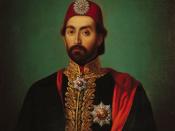Geographic Background
Turkey occupies a region partly in Europe and partly in Asia. European Turkey, known as eastern THRACE, is bounded on the north by the BLACK SEA and Bulgaria and on the west by the AEGEAN SEA and Greece. It is separated from Asian Turkey (ANATOLIA or Asia Minor) by the BOSPORUS, the Sea of MARMARA, and the DARDANELLES Strait. Anatolia is bounded on the north by the Black Sea; on the east by Georgia, Armenia, and Iran; on the south by Iraq, Syria, and the Mediterranean Sea; and on the west by the Aegean Sea .
June 28, 1997, Nekmettin Erbakan becomes Turkey's first Islamic Prime Minister. Few United States newspapers published this turn in leadership and even less publicity declared the dramatic ramifications of such an election for the new head of government. Defined as a Republican Parliamentary Democracy the Republic of Turkey had been a secular nation for 73 years.
With an Islamic majority in Parliament dramatic changes are inevitable. Press in the United States has been minimal because the country is a half a world away; however, the citizens of this nation should be concerned. 'The United States over the past 10 years has supplied Turkey with $5.3 billion in military aid,' such extraordinary power with an abrupt shift in leadership will be very dangerous within the country and internationally. To predict what is looming in the future of Turkey it is best to examine the history that brought the country to elect such a leader, and how it will interplay with current conditions and leadership within the country. Turkey is historically linked to Islamic principles, while simultaneously founded on western idealism. Geographically Turkey is both part of Europe and Asia. A portion, Eastern Thrace, is considered part of Europe and the rest, Asia Minor.


